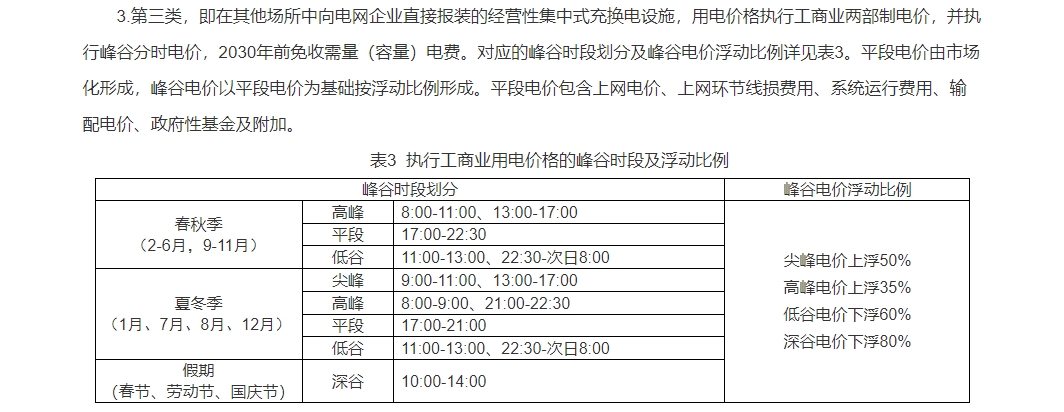Recently, the Zhejiang Provincial Development and Reform Commission and the Provincial Market Supervision Bureau issued the "Notice on Further Optimizing and Regulating the Electricity Price of Electric Vehicle Charging and Swapping Facilities", proposing to optimize the peak and valley electricity prices of commercial charging and swapping facilities, setting an all-day 11.5 During the 2-hour trough period, the peak electricity price increase ratio was reduced from the original 80% to 50%, and the low valley electricity price decrease ratio was expanded from the original 53% to 60%. It is expected that after the implementation of the policy, the average electricity price of charging and swapping facilities in Zhejiang will drop by 10% to 15%.
The detailed optimization situation is as follows:
1. Optimize and standardize electricity prices for charging and swapping facilities
In accordance with the principle of classified management, electric vehicle charging and swapping facilities are divided into four categories for price management.
1. The first category refers to the charging and swapping facilities that are installed directly to the power grid company in residential homes and non-resident users who are subject to residential electricity prices. The electricity prices are based on the residents' combined meter prices, and they can choose to implement the electricity price per unit or peak-valley price. Hourly electricity prices, the specific price levels are shown in Table 1.

2. The second category refers to the charging and swapping facilities (including centralized ones) installed directly to the power grid company in residential areas. The electricity price shall be based on the residents' combined meter price, and the peak and valley time-of-use electricity price shall be implemented. The specific price levels are shown in the table. 2.

3. The third category, that is, operating centralized charging and swapping facilities that are installed directly to the power grid company in other places, the electricity price shall comply with the two-part industrial and commercial electricity price, and the peak and valley time-of-use electricity price shall be implemented. It will be exempted before 2030. Demand (capacity) electricity charges. The corresponding peak and valley period divisions and peak and valley electricity price floating ratios are detailed in Table 3. The flat electricity price is formed by marketization, and the peak and valley electricity prices are formed in a floating proportion based on the flat electricity price. The flat section electricity price includes the on-grid electricity price, line loss costs in the on-grid link, system operating costs, transmission and distribution prices, government funds and surcharges.

4. The fourth category, that is, all charging and swapping facilities that have not been directly reported to the power grid company for installation, the electricity price shall be based on the electricity price corresponding to the location.
2. Standardize charging behavior for battery charging and replacement services
1. In addition to charging electricity fees from users, operating entities of electric vehicle charging and swapping facilities can also charge service fees from users. The service fees are subject to market-regulated prices and are independently determined by the operating entities based on covering costs and reasonable profits.
2. Business entities should strictly implement clear price tags and publicize charging prices in conspicuous locations such as business premises and charging and swapping APPs, including three price information: the total charging unit price (i.e., "one price") and the unit price of electricity and service fees. (See Table 4 for examples). Any unspecified fees shall not be charged in addition to the listed price.
3. Business entities should recover costs other than electricity bills and obtain profits through service fees, and shall not charge other fees to electricity bills.


The automobile industry faces an important period of development opportunities
Since the beginning of this year, the automobile market has continued to perform well. At this···

China Automobile Synergy Zongqi: Charging infrastructure should show differentiated development
The 2023 China Automobile Charging and Swapping Ecosystem Conference was held in Hangzhou. Ton···

Xinjiang charging pile access monitoring module creates information security
State Grid Xinjiang Information and Communications Corporation recently completed the charging···

Zhejiang Development and Reform Commission: Standardizing electricity prices for electric vehicle charging and swapping facilities is expected to drop by 10%-15%
Recently, the Zhejiang Provincial Development and Reform Commission and the Provincial Market Superv···

Shenxing superchargeable battery wins award, new choice for 750 million European consumers
Looking around the world, since 2023, battery companies have been competing with each other, and ult···

Super fast charging “makes charging as fast as refueling”
In recent years, the state has successively introduced favorable policies for the construction of su···